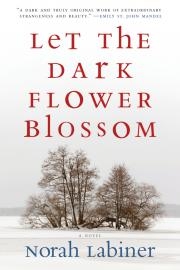
Let the Dark Blossom Flower
by Norah Labiner
Coffee House Press
Norah Labiner is not interested in linear storytelling or books with a traditional beginning, middle and end. You should know this before you read her work. You should know this before you commit to reading her latest novel, Let the Dark Flower Blossom. You should prepare to be challenged if you are not accustomed to books featuring five different story lines in alternating paragraphs. At the same time, you should expect to be enthralled by passages written in vivid and lyrical language that often read like poetry, in form and content, even though this is prose deliberately open to interpretation—or misinterpretation.
Let the Dark Flower Blossom tests readers’ ability to piece together events that zig and zag and digress in no apparent order. Labiner sprinkles the novel with clues, but some don’t register on a first reading. For example, her book opens with a first-person account from a character who periodically appears throughout the book but is not identified until page 153.
This experimental novel is a twisted mystery: Roman Stone, a famous writer, has been murdered and his friends, Sheldon and Eloise Schell—twins—must figure out who stabbed him with a pair of scissors. (Sounds like a game of Clue, doesn’t it?) The book, however, could hardly be classified as hard-boiled genre; if anything, it verges on Gothic.
This is a book of murder mysteries within murder mysteries. Peeling one story opens up another. As teenagers, the Schell twins’ parents are killed, and it’s not clear who is the culprit. Each twin provides a different account of the events that left them orphans. Later, a hitchhiker is murdered, and it’s not apparent who is responsible or why because Sheldon and Roman give differing accounts, each blaming the other. Much later, Sheldon’s wife dies and it’s suggested that the impetus might not have been natural causes. All this before Stone gets pricked with those scissors.
One of the book’s themes is questioning how people tell stories. Labiner includes a character who debunks victims’ memories in court. He’s married to Eloise and a pretty despicable character who frees heinous murderers and rapists by discrediting victims who clearly are telling the truth. This so-called “memory expert” provides a continuous diatribe throughout the novel about perception, how the ability to recall events is flawed, how people tell stories differently each time they give an account— just like the characters who populate Let the Dark Flower Blossom.
This is a novel full of unreliable narrators. Labiner wants the reader to choose which version of the story he or she wants to believe or which account is more credible based on the myriad of details Labiner provides. Much of the book is a labyrinth of evidence set out for readers often before they have the background to understand the significance of what they are reading. It’s a book that might make more sense—and be more pleasurable—on a second reading.
That’s not to suggest that the book is not pleasurable, at times. The scenes are detailed and evocative. Labiner skillfully describes common foods in ways that make them seem exotic. Despite being set in modern times and in the United States, the book has a decidedly Old World feel. There are rare cultural references—no Starbucks or fast food or rock music or current movie stars—and the characters spend most of their time reading or writing literature, telling stories, playing chess or walking in the snow or ferreting in the woods. And the foods they eat evoke a distant era: “The coffee was bitter black boiled through with cardamom and sweetened with honey…This was the last morning, wasn’t it? of coffee and oranges and green birds.” The characters eat licorice, bananas, figs, Goody orange soda pop, orange marmalade, chocolate oranges and Swedish cake with elderberry, espresso, pepper and oranges. Oranges are a motif that appear throughout the book to symbolize the death that ties Roman and Sheldon together.
Labiner could have set the book fifty years earlier and it might have given the novel more veracity. Who uses a typewriter these days, especially if they came of age in the 1980s? Yet Labiner’s characters are so obsessed with typing their stories on typewriters that she includes a maudlin and gimmicky “artist’s statement” with the book’s review copy noting she wrote the manuscript on a portable typewriter: “The violence with which each metal key struck the page is imprinted into the story,” she writes, suggesting that the story is different because each word was the result of a key striking paper. Maybe. And maybe it just made her more averse to revision, especially not deleting repetitive sentences.
Labiner is playing here with structure and story, the results of which are mixed. Her writing is beautiful, and, at times, the book seems more like a work of verse, aided by short, one-line sentences that fill pages and pages. If Labiner has an irritating quirk, it’s repeating the same lines multiple times. We get it. We get it. We get it.
“This is a story about a murder,” Labiner writes in her artist’s statement. “It is a book about violence. Let the Dark Flower Blossom is a book about readers who love mystery….About that moment of realization when you solve the crime just before the detective walks into the library brandishing a candle and a hand mirror to reveal the true identity of the killer.”
So, read the book, maybe more than once. Take notes, tack yellow stickies throughout, use a highlighter, underline, write in the margins, make a timeline, jot down clues, because you’re going to need a few bread crumbs to find your path through this novel. For some readers, that will be fun.


